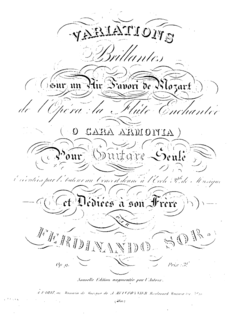
Introduction and Variations on a Theme by Mozart (Sor)
Encyclopedia

Fernando Sor
Josep Ferran Sorts i Muntades was a Spanish classical guitarist and composer. While he is best known for his guitar compositions, he also composed music for a wide range of genres, including opera, orchestra, string quartet, piano, voice and ballet...
's most famous works for guitar. It was first published in London in 1821 and dedicated to Sor's brother Carlos.
Editions
The first edition was written, published, and performed at a party, or parties at the homes of nobilities in London. We know this from the title page, which reads “As performed by the author, at the Nobilities’ Concerts.” The French edition was published by Meissonnier, dated roughly in the same period, and had one less variation, no coda, and some differing notes. It is thought that this version could have been a simplification of the original work. However, in 1826 or 27, Meissonnier brought out another version, this one identical to the London first edition.The piece
This piece embodies Fernando Sor's best characteristics as a composer, requiring great technique. It is a relatively frequently performed piece that serves as a “testing ground for every aspiring guitarist.” As said of this piece and Op.7, the Folies d’Espagne, by Brian Jeffrey, author of the largest Sor biography to date, “no space is wasted and the music devotes itself not to “guitaristic” effects but only to itself.”The work is based on a melody from Mozart's opera The Magic Flute
The Magic Flute
The Magic Flute is an opera in two acts composed in 1791 by Wolfgang Amadeus Mozart to a German libretto by Emanuel Schikaneder. The work is in the form of a Singspiel, a popular form that included both singing and spoken dialogue....
. The opera was first performed in Vienna, 1791, and in German, while the first performances in Italian took place in 1794, so Sor could have feasibly written the piece any time since then. However, it is more likely that he was inspired to write the piece when the first major production was premiered in England in May 1819, when Sor was in the area.
The theme the variations are based on is one that was used in numerous composer's arrangements, some being by the flautist Drouet, by Herz, and by Mikhail Glinka
Mikhail Glinka
Mikhail Ivanovich Glinka , was the first Russian composer to gain wide recognition within his own country, and is often regarded as the father of Russian classical music...
. It is the theme played near the end of Act I called “Das klinget so herrlich”, in Italian either translating to "O dolce concento", "O dolce armonia", or, as Sor chose to use, "O cara armonia". This last translation was also used in the vocal score of The Magic Flute published in Birchall, London in around 1813.

